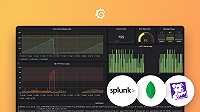Catchpoint Grafana data source
Note
This plugin is in a public preview. Refer Grafana Labs release life cycle documentation for further details. If you notice any issues or having feature request, create a support ticket with your Grafana Enterprise support channel.
The Catchpoint data source plugin allows you to query and visualize Tests, RUM and SLO data from within Grafana.
Requirements
This plugin has the following requirements:
- A Catchpoint account
- Any free or paid Grafana Cloud plan or an activated on-prem Grafana Enterprise license. Contracted Cloud customers should refer to their agreement.
Install the plugin
To install the data source, refer to Installation.
Configure the data source in Grafana
Add a data source by filling in the following fields:
Basic fields
Authentication fields
This plugin supports Bear token based authentication. Log into Catchpoint portal, then go to Settings > API and find Rest API V2 Key under the REST API section.
Configure the data source with provisioning
It is possible to configure data sources using configuration files with Grafana’s provisioning system. To read about how it works, including all the settings that you can set for this data source, refer to Provisioning Grafana data sources
Here are some provisioning examples for this data source using access key authentication:
apiVersion: 1
datasources:
- name: Catchpoint
type: grafana-catchpoint-datasource
jsonData:
authMethod: bearer
secureJsonData:
catchpoint.token: <token>Query the data source
The query editor allows you to write queries - Tests, RUM, and SLO. Select the action type and enter required parameters and optional parameters where applicable.
Known limitations
Due to limitations of the Catchpoint API at the moment it’s not possible to filter by specific dimension values when using Tests Query. When selecting dimension the data for all dimension values will be returned.
Explore view
The Explore view allows you to run queries and visualize the results as logs or charts for metrics. For more information about Explore, refer to Explore.
Templates and variables
To add a new Catchpoint query variable, refer to Add a query variable. Use your Catchpoint data source as your data source and fill out the query field with your query.
After creating a variable, you can use it in your Catchpoint queries using Variable syntax. For more information about variables, refer to Templates and variables.
Learn more
- Add Annotations.
- Configure and use Templates and variables.
- Add Transformations.
- Set up alerting; refer to Alerts overview.



